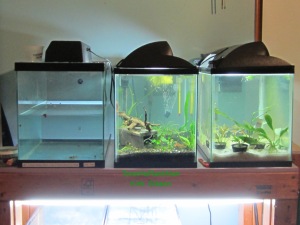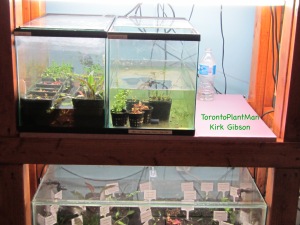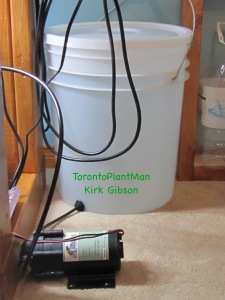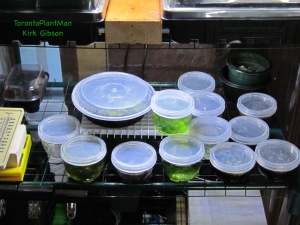Many people have asked me how to start an emersed set up so I thought it’d be best to go ahead and do this write up; please keep in mind I’m in the process of clearing out many of my plants and tanks since I’ll be moving to Australia in early 2015. With that said many of the pictures you will see won’t have as many plants in the tanks as they normally would but this will still give you an idea of how to start an emersed set up for aquatic plants.
My set up consists of a three tier set up, one custom made 33 gallon aquarium on the bottom, three 10 gallon tanks in the middle section, and three 10 gallon tanks on the upper section. I recently removed one of the 10 gallon aquariums from the middle row and took one from the upper row of the stand to complete the middle section again; the upper section of the stand now only consist of two 10 gallon tanks. Every tank of course has a lid on it which consists of two pieces of glass, one that can slide over the other for easy access in and out of the tank; this is an absolute must for growing emersed aquatic plants, especially if you’re going to be in and out of your tanks a lot.
I’ll write how everything is controlled and any tips/tricks through the pictures below:
Here is the 33 gallon custom aquarium on the lowest level of the three tier stand; this tank houses 75% rare cryptocorynes and the rest are anubias and some stem plant species I’m experimenting with under lower light. Every pot in this tank has the same substrate, lighting, and misting schedule since they are all in the same tank, here are the specs :
Lighting – Dual bulb Coralife T5NO fixture with 6700k and rosette bulb, approx. 10 inches above the tank. 10 hour photo period.
Substrate- Cow manure, Sheep Manure, Worm Castings, Natural Red Clay, & Top Soil.
Misting- 20 seconds every 3 hours via Mist King pump.
Plants – Cryptocoryne Cordata Var. Siamensis ‘Blassii’, Cryptocoryne Cordata Var. Siamensis ‘Rosanervig’, Cryptocoryne Cordata Var. Siamensis ‘Thailand Sungai Kolok’, Cryptocoryne Cordata Var. Grabowski ‘1952 Shirley Aquatic’s’ , Cryptocoryne Sp. ‘Flamingo’, Cryptocoryne Moehlmannii ‘Sosak’, Cryptocoryne Purpurea Nothovar Purpurea ‘Kota Tinggi’, Cryptocoryne Nurii ‘Pahang Mutated’, Cryptocoryne sp. Affinis aka Cryptocoryne Haerteliana, Cryptocoryne Cf. Affinis, Anubias Barteri Nana, Anubias Barteri Nana Petite, Anubias Congensis, Alternanthera Reineckii Var. Roseafolia Mini, and Ludwigia Repens.



This is the top level of the stand where originally one emersed and two submersed tanks sat; as you can see I’ve cleared out the emersed tank on the left as well as many of the plants from the submersed tanks. Currently the two submersed tanks are just used for housing smaller fish/fry and any plants before they go into my main display tank in my room or into the grow out tanks. Both submersed tanks are connected to the main air pump while also having HOB filter’s to provide extra filtration for the fish.

The middle level does have three 10 gallon tanks again, I just haven’t taken a new pictures since the tank is still empty anyway. On the left hand side you’ll see an emersed tank which is also connected to the MistKing pump and includes the same substrate as above except the lighting is four T5NO shop lights with two 6700k bulbs and two rosette bulbs for a total of 4 T5 bulbs which sit approx. 6 inches above the tanks. I use these tanks for my higher light plants or any plants in which I’m trying to grow at a faster pace as opposed to the 33 gallon tank where everything in there is grown very slow.

This is where the magic happens in terms of misting and all the power connections; as you can see a food safe 5 gallon bucket filled with R.O.D.I water acts as the reservoir to feed the MistKing pump which is then connected to all the emersed tanks to receive a 20 second misting every 3 hours during the 10 hour lighting period. The air pump is an Active Aqua Commercial Air Pump with 6 outlets, 45 LPM, 713 GPH and surprisingly only 20 watts! I picked this up on Amazon for less than $50 shipped to my house which is a steal considering what you’d pay at the local fish store for a basic air pump that still isn’t as powerful as this one; my only complaint is it’s a bit noisy but I didn’t expect silence for $50 so I’m satisfied. I have two main power stations which control the plant room; they are identical which is why I only took a picture of one but one is for all the lights which is plugged into a timer, while the other one is for everything that always needs to stay on like the air pump, filters, etc.



This last little set up contains two high humidity domes where I normally grow out different Cryptocoryne’s and carpet plants like Glosso or H.C Cuba; the lighting on the first level consist of two 23watt 6700k daylight CFL bulbs. Since the lights can get quite hot I rigged up an old computer fan I found in the garbage to some spare wire’s I had from previous electronic projects and placed this behind the lights blowing the warm air outside of the tent/domes to keep the temperature down. During the night when the lights are off the fan also goes off in order to not cause a drop in temperature.
The second row is used for growing mosses like Singapore Moss, Flame Moss, Riccia, and even H.C Cuba in smaller pots which I was surprised to see grow. I have these plants on the second row under a much lower light; just a cheap Marineland LED that came with my tank when I first bought it.




The most important thing when growing aquatic plants emersed is that you maintain a high humidity inside the tanks or domes that you are using, anywhere between 75-85% is what I’ve found to be best, although some plants may need a higher humidity like if you were to try growing a Crinum species. Another important thing to keep in mind is the water level in the tanks, I’ve found if the water level is too close to the top of your pots and your soil appears to be very wet you’re going to have bad algae problems; I always try to keep my water level 3/4 of the way to the top of the pot, making sure that the top of the soil is damp and firm, not soaked and mushy.
Another thing to keep in mind is how you will mist your plants ? If you have a large number of tanks and grow set ups physically misting them every day can be a pain in the butt; investing in equipment like a MistKing pump will save you time to look after other things and money on wasted water from over misting. Be careful not to mist too often during the day or you will increase your overall water level within a few days and possibly have an algae outbreak on your hand if not looked after in a timely manner.
Here is a full list of all the plants I have inside all the tanks:
Stem Plants
Ammania Sp. ‘Bonsai’ True Rotala Indica
Alternanthera Reineckii Var. Roseafolia Mini
Ludwigia Repens
Bacopa Monnieri
Rotala Rotundifolia
Rotala Macaranda
Staurogyne Repens
Hygrophilia Polysperma ‘Rosanervig’ – ‘Sunset Hygro’
Pogostemon Helferi ‘Downoi’
Pogostemon Erectus
Rooted Plants
Cryptocoryne Cordata Var. Siamensis ‘Blassii’
Cryptocoryne Cordata Var. Siamensis ‘Rosanervig’
Cryptocoryne Cordata Var. Siamensis ‘Thailand Sungai Kolok’
Cryptocoryne Cordata Var. Grabowski ‘1952 Shirley Aquatic’s’
Cryptocoryne Moehlmannii ‘Sosak’
Cryptocoryne Purpurea Nothovar Purpurea ‘Kota Tinggi’
Cryptocoryne Crispatula Var. Tonkinensis
Cryptocoryne Sp. Affinis AKA. Cryptocoryne Haerteliana
Cryptocoryne Cf. Affinis
Cryptocoryne Lucens
Cryptocoryne Aponogetifolia ‘Sorsogon’
Cryptocoryne Nevillii
Cryptocoryne Wendtii ‘Brown’
Cryptocoryne Wendtii ‘Green’
Cryptocoryne Wendtii ‘Green Gecko’
Cryptocoryne Wendtii ‘Mi Oya’
Cryptocoryne Wendtii ‘Tropica’
Cryptocoryne Wendtii Sp. ‘Flamingo’
Cryptocoryne Nurii ‘Pahang Mutated’
Cryptocoryne Pontederiifolia
Cryptocoryne Retrospiralis
Hemianthus Callitrichoides “Dwarf Baby Tears”
Sagittaria Subulata – ‘Dwarf Sagittaria’
Echinodorus Tenellus ‘Micro’
Echinodorus Amazonicus
Vallisneria Americana
Glossostigma Elatinoides
Lilaeopsis Brasiliensis ‘Micro Sword’
Marsilea Crenata
Floaters/Mosses Etc.
Riccia Fluitans – Crystalwort
Riccardia Chamedryfolia – Mini Pellia
Monosolenium Tenerum – Pellia
Vesicularia Dubyana – Singapore Moss
Vesicularia Montagnei – Christmas Moss
Limnobium Laevigatum- Amazon Frogbit
Lemnoideae – Duckweed
Spirodela Polyrrhiza – Giant Duckweed
Taxiphyllum Sp. ‘Flame Moss’
Subwassertang
Fissidens Fontanus ‘Phoenix Moss’
Eichhornia Crassipes ‘Water Hyacinth’
Rhizome Plants
Anubias Barteri
Anubias Barteri Var. Nana
Anubias Barteri Var. Nana Petite
Anubias Barteri Var. Congensis
Anubias Lanceolata
Anubias Frazeri
Bolbitis Heudelotii
Microsorum Pteropus ‘Narrow Leaf’
Microsorum Pteropus ‘Trident’
Microsorum Pteropus ‘Windelov’
Bulb Plants
Nymphaea Lotus ‘Red’
Nymphaea Caerulea
Barclaya Longifolia ‘Green’
Crinum Calamistratum
Floaters
Giant Duckweed
Amazon Frogbit
If anyone ever has any questions, comments or needs help feel free to e-mail me or comment below and I’ll be sure to reply.

Thanks for sharing your great emersed setup I’m currently working on a simular project And using blogs like this to improve on my ideas.
For more details please see my journal over at glassboxgardeners.com
Thanks
Hey,
No problem I’m glad it helped you out. I’ll be sure to check out your website.
Kirk
Please do Kirk it would be great having your knowledge and input 🙂
The setup I mentioned can be found here.
http://glassboxgardeners.com/members-journals/311-emersed-aquatic-plant-hydro-aquaponics-rack-system.html
Hope to see you soon 🙂
I checked out your thread; personally I would not keep that many species all under the same conditions; you’re limiting yourself in terms of the species you can keep and how well they will do since you’ll have everything on the same system; basically all with the same PH which is not a good thing. I understand you want to use some kind of “centralized” filtration but this is somewhat unnecessary when growing plants emerged; 90% of people grow them in stagnant water, sometimes people will add flow via a powerhead but again it depends on the species.
Try to separate the species you have in terms of PH/water parameters, and then break those plants down into separate tanks which don’t use the same water as a different group of plants which would require a different PH.
Best of luck
Kirk
Thanks for the information 🙂
The filter itself may not be used yet, the reason i added it to the system plan was i had it already available doing nothing, as for the mix of plants from my tests i’ve had no problems the last few years mixing plants but this may change as i decide on new species.
Just in case i do have some separate containers setup that are isolated from the main system allowing me to alter the parameters if i need to for certain plants.
Thanks
Thanks for all this info. Im starting to grow some Hemianthus Callitrichoides “Dwarf Baby Tears” in 2 tanks with this dry start method (emmerged growing), by buying some bags of seeds to start with.
hydrocotyle tripartitaand and java moss will grow on filter sponge?